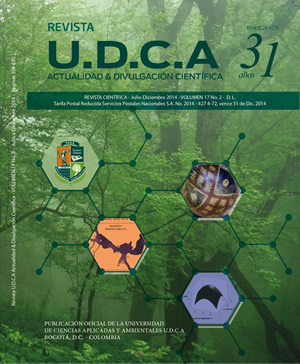Crecimiento y eficiencia fotoquímica del fotosistema II en plantas de fresa (Fragaria sp.) Afectadas por la calidad de la luz: implicaciones agronómicas
Growth and photochemical efficiency of photosystem II in strawberry plants (Fragaria sp.) Affected by the light quality: agronomic implications
Contenido principal del artículo
Resumen
Fotomorfogénesis es cualquier cambio de forma o de función en un organismo, que sucede en respuesta a las modificaciones en la luz ambiental. La calidad de la luz, se capta mediante receptores específicos para las diferentes longitudes de onda. En un ensayo factorial, se evaluó la influencia de la calidad de la luz sobre el crecimiento y la eficiencia fotoquímica del fotosistema II (PSII) en plantas de fresa (Fragaria sp., cv. Chandler), bajo invernadero, en Tunja, Colombia. Las plantas crecieron bajo diferente calidad de luz (amarilla, verde, azul, roja, transparente y el control sin cobertura), proporcionada por películas filtro de polipropileno. Se realizaron determinaciones de florescencia mínima (F0), máxima (Fm), variable (Fv), terminal (Ft) y la eficiencia fotoquímica máxima (Fv /Fm), en hojas adaptadas a la oscuridad, 32 semanas luego del trasplante. En relación con el crecimiento, las plantas control registraron los valores más altos de materia seca por planta y de peso específico de las hojas. Las plantas bajo el filtro rojo desarrollaron la mayor área foliar, mientras que el filtro verde redujo el crecimiento. Las películas de color modificaron el patrón de asignación de materia seca en los órganos de las plantas, especialmente, el filtro de color verde. La luz filtrada afectó todos los parámetros de la fluorescencia de la clorofila. En relación con las plantas control Fv , Fm y Ft fueron mayores en las plantas que crecieron bajo todas las coberturas. Mientras que F0 fue mayor bajo las coberturas amarilla y transparente, Fv /Fm fue menor bajo esas películas filtro. Los resultados se discuten en relación con sus posibles implicaciones sobre prácticas agronómicas apropiadas.
Palabras clave:
Descargas
Datos de publicación
Perfil evaluadores/as N/D
Declaraciones de autoría
- Sociedad académica
- Universidad de Ciencias Aplicadas UDCA
- Editorial
- Universidad de Ciencias Aplicadas y Ambientales U.D.C.A
Detalles del artículo
Referencias (VER)
BACARIN, M.A.; MOSQUIM, P.R. 2002. Cinética de emissão de fluorescência das clorofilas de dois genótipos de feijoeiro. Ciência e Agrotecnologia, Lavras. 26(4):705-710.
BAKER, N.R.; ROSENQVIST, E. 2004. Applications of chlorophyll fluorescence can improve crop production strategies: an examination of future possibilities. J. Exp. Bot. 55(403):1607-1621.
BRADBURNE, J.A.; KASPERBAUER, M.J.; MATHIS, J.N. 1989. Reflected Far-Red light effects on cholorophyll and light-harvesting chlorophyll protein (LHCII) contents under field conditions. Plant Physiol. 91(3):800-803.
BRIANTAIS, J.M.; VERNOTTE, C.; KRAUSE, G.H.; WEIS, E. 1986. Chlorophyll fluorescence of higher plant chloroplasts and leaves. In: Govindjee, J.A.; Fork, D.C., Eds. Light emission by plants and photosynthetic bacteria. Academic Press, New York. p.539-577.
CASIERRA-POSADA, F.; ROJAS B., J.F. 2009. Efecto de la exposición del semillero a coberturas de colores sobre el desarrollo y productividad del brócoli (Brassica oleracea var. italica). Agr. Col. 27(1):49-55.
CASIERRA-POSADA, F.; PEÑA-OLMOS, J.E. 2011. Contenido de pigmentos en hojas de fresa (Fragaria sp) expuestas a diferente calidad espectral. Agr. Col. (en prensa).
CASIERRA-POSADA, F.; PEÑA-OLMOS, J.E.; ULRICHS, C. 2011. Análisis básico del crecimiento en plantas de fresa (Fragaria sp.) expuestas a diferente calidad de luz. Agr. Col. (en prensa).
CHEN, K.; HU, G.; KEUTGEN, K. 1999. Effects of NaCl and CO2 enrichment on pepino (Solanum muricatum Ait) II. Leaf photosynthetic properties and gas exchange. Sci. Hort. 81:43-56.
DECOTEAU, D.R. 2008. The emergence and early development of colored reflective plastic mulch technology in agriculture. En: Stevens, C.; Khan, V.A. (eds). Recent advances in agriculture. Research Signpost. Kerala, India. p.1-17.
DEMMIG-ADAMS, B.; ADAMS, III W.W. 1992. Photochemical and other responses of plants to high light stress. Ann. Rev. Plant Physiol. Plant Mol. Biol. 43:599-626.
EL-SHARKAWY, M.A. 2007. Physiological characteristics of cassava tolerance to prolonged drought in the tropics: Implications for breeding cultivars adapted to seasonally dry and semiarid environments. Braz. J. Plant Physiol. 19(4):257-286.
F OLTA, K.M.; MARUHNICH, S.A. 2007. Green light: a signal to slow down or stop. J. Exp. Bot. 58:3099-3111.
F UKUDA, N.; FUJITAN, M.; OHTA, Y.; SASE, S.; NISHIMURA, S.; EZURA, H. 2008. Directional blue light irradiation triggers epidermal cell elongation of abaxial side resulting in inhibition of leaf epinasty in geranium under red light condition. Sci. Hort. 115:176-182.
GONÇALVES, J.F. de C.; MARENCO, R.A.; VIEIRA, G. 2001. Concentration of photosynthetic pigments and chlorophyll fluorescence of Mahogany and Tonka bean under two light environments. Rev. Bras. Fisiol. Veg. 13(2):149-157.
GONZÁLEZ M., S.; PERALES V, H.; SALCEDO A., M.O. 2008. La fluorescencia de la clorofila a como herramienta en la investigación de efectos tóxicos en el aparato fotosintético de plantas y algas. Rev. Educación Bioquímica. 27(4):119-129.
HALIAPAS, S.; YUPSANIS, T.A.; SYROS, T.D.; KOFIDIS, G.; ECONOMOU, A.S. 2008. Petunia x hybrida during transition to flowering as affected by light intensity and quality treatments. Acta Physiol. Plant. 30:807-815.
HIROSE, T. 1987. A vegetative plant growth model: adaptive significance of phenotypic plasticity in matter partitioning. Functional Ecol. 1:195-202.
IMAIZUMI, T.; TRAN, H.G.; SWARTZ, T.E.; BRIGGS, W.R.; KAY, S.A. 2003. FKF1 is essential for photoperiodicspecific light signalling in Arabidopsis. Nature. 426:302- 306.
JIAO, Y.; LAU, O.S.; DENG, X.W. 2007. Light-regulated transcriptional networks in higher plants. Nat. Rev. Genet. 8:217-230.
LOUGHRIN, J.H.; KASPERBAUER, M.J. 2002. Aroma of fresh strawberries is enhanced by ripening over red versus black mulch. J. Agric. Food Chem. 50:161-165.
MANRIQUE, E. 2003. Los pigmentos fotosintéticos, algo más que la captación de luz. Ecosistemas 12(1). Disponible desde internet en: http://rua.ua.es/dspace/ bitstream/10045/8958/1/ECO_12%281%29_08.pdf. (con acceso 22/07/2011).
MIRANDA, J.H.; WILLIAMS, R. 2007. Developmental influence of in vitro light quality and carbon dioxide on photochemical efficiency of PS II of strawberry leaves (Fragaria x ananassa). J. Appl. Hort. 9(1):13-16.
MATHEWS, S. 2010. Evolutionary studies illuminate the structural–functional model of plant phytochromes. The Plant Cell. 22:4-16.
NIYOGI, K.K. 1999. Photoprotection revisited: Genetic and molecular approaches. Ann. Rev. Plant Physiol. Plant Molec. Bio. 50:333-359.
PERCIVAL, G.C. 2004. Evaluation of physiological tests as predictors of young tree establishment and growth. J. Arboric. 30(2):80-92.
PERCIVAL, G.C.; HENDERSON, A. 2003. An assessment of the freezing tolerance of urban trees using chlorophyll fluorescence. J. Hortic. Sci. Biotech. 78(2):254-260.
REEKIE, E.G.; BAZZAZ, F.A. 1987. Reproductive effort in plants: effect of reproduction on vegetative activity. Am. Naturalist. 129:907-919.
SHAHAK, Y.; GAL, E.; OFFIR, Y.; BEN-YAKIR, D. 2008. Photoselective Shade Netting Integrated with Greenhouse Technologies for Improved Performance of Vegetable and Ornamental Crops. Acta Hort. 797:75-80.
STRASSER, B.; SÁNCHEZ-LAMAS, M.; YANOVSKY, M.J.; CASAL, J.J.; CERDÁN, P.D. 2010. Arabidopsis thaliana life without phytochromes. Proc. Nal. Acad. Sci. U.S.A. 107:4776-4781.
TERASHIMA, I.; HANDA, Y.T.; TAZOE, Y.; VYAS, P.; YANO, S. 2005. Irradiance and phenotype: comparative ecodevelopment of sun and shade leaves in relation to photosynthetic CO2 diffusion. J. Exp. Bot. Phenothypic Plasticity and the Changing Environm. Special Issue. 57(2):343-354.
VALLADARES, F.; NIINEMETS, Ü. 2008. Shade Tolerance, a Key Plant Feature of Complex Nature and Consequences. Ann. Rev. Ecol. Evolution and Systematics. 39:237-257.
VIEIRA, D.A. de P.; PORTES, T. de A.; STACCIARINISERAPHIN, E; TEIXEIRA, J.B. 2010. Fluorescência e teores de clorofilas em abacaxizeiro cv. pérola submetido a diferentes concentrações de sulfato de amônio. Rev. Bras. Frutic. 32(2):360-368.
WEINER, J. 2004. Allocation, plasticity and allometry in plants. Perspectives in Plant Ecol., Evol. and Systematics. 6(4):207-215.
WILLITS, D.H.; PEET, M.M. 2001. Using chlorophyll fluorescence to model leaf photosynthesis in greenhouse pepper and tomato. Acta Hortic. 507:311315.







